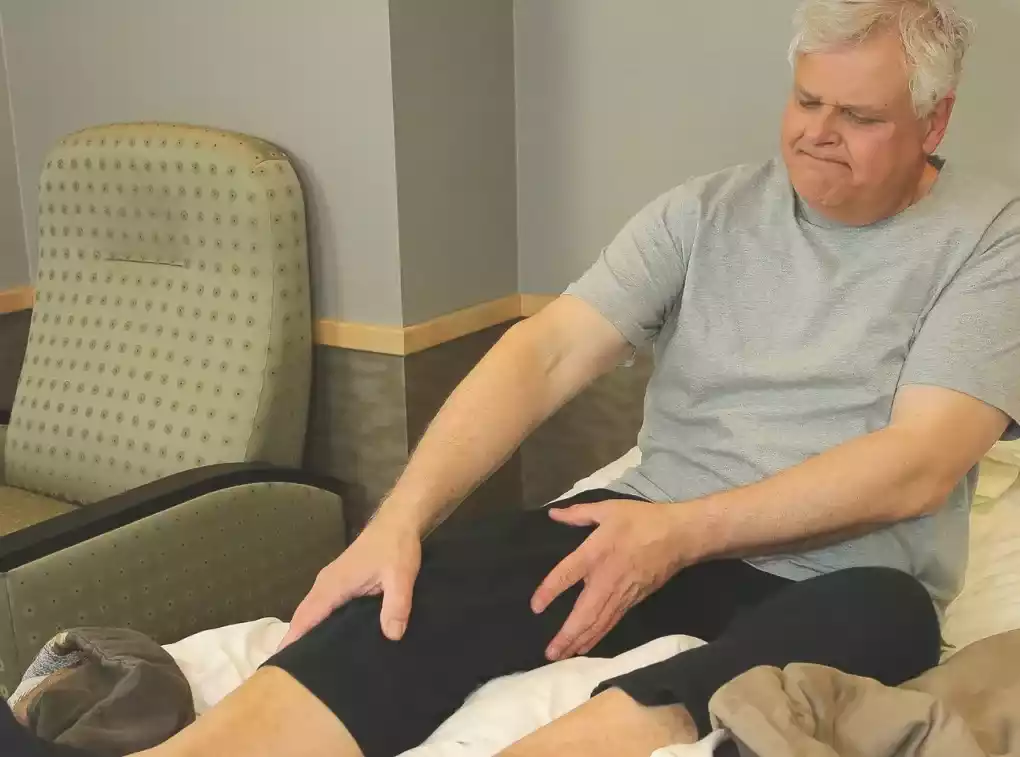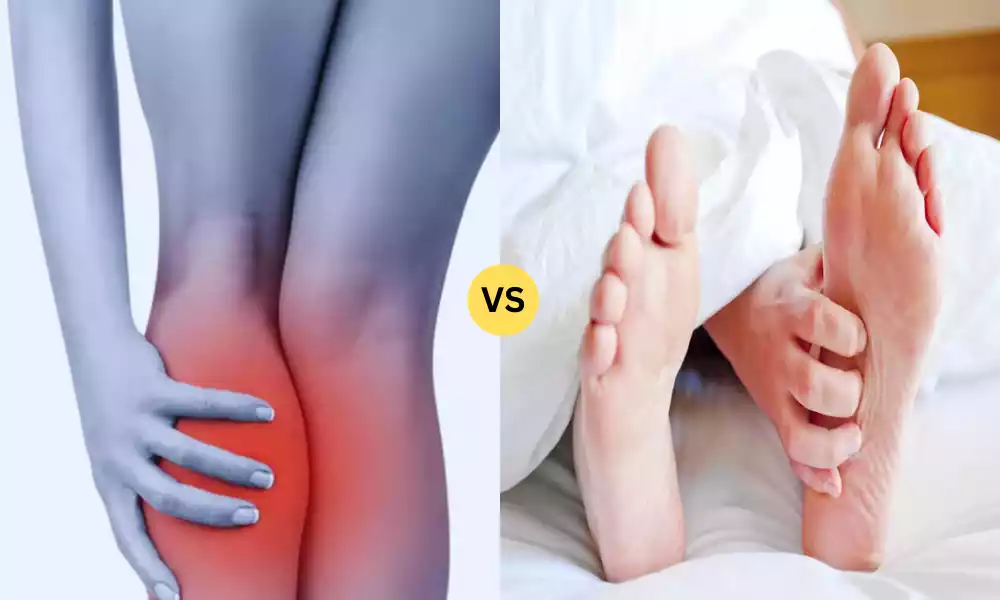RLS and PLMD are two distinct yet closely related sleep disorders that can significantly impact an individual’s quality of life. RLS is characterized by uncomfortable sensations in the legs, often accompanied by an irresistible urge to move them for relief. This condition predominantly occurs when awake and can disrupt both daytime activities and sleep.
PLMD involves periodic limb movements during sleep, causing interruptions in the sleep cycle and potentially leading to excessive daytime sleepiness. While both disorders share certain symptoms and challenges, understanding their unique characteristics is crucial for accurate diagnosis and effective management.
What is RLS?

Restless Legs Syndrome, commonly referred to as Willis-Ekbom Disorder, is a neurologic condition which produces unpleasant sensations in the legs. People with RLS often experience a strong urge to move their legs to alleviate these sensations, which are often described as crawling, tingling, itching, or aching. These sensations typically worsen when at rest, particularly during periods of inactivity or when lying down, and they tend to improve with movement.
As a result, RLS can significantly disrupt sleep and lead to difficulty falling asleep or staying asleep, leading to daytime fatigue and impairment. The exact cause of RLS is not fully understood, but genetic factors and imbalances in certain brain chemicals, particularly dopamine, are believed to play a role.
Iron deficiency and certain medical conditions can also contribute to RLS. Treatment options for RLS include lifestyle changes, managing underlying conditions, and medications to alleviate symptoms and improve sleep quality.
Symptoms of RLS
The primary symptoms of Restless Legs Syndrome (RLS) include:
- Uncomfortable Sensations: Individuals experience unusual and often unpleasant sensations in the legs, such as crawling, tingling, itching, or aching.
- Urge to Move: There’s an overwhelming urge to move the legs to find relief from the discomfort.
- Aggravation at Rest: Symptoms tend to worsen when at rest or during periods of inactivity, particularly when lying down or sitting for extended periods.
- Relief with Movement: Movement, such as walking or stretching, can temporarily alleviate the sensations and urge to move.
- Nocturnal Disruption: RLS symptoms often intensify during the evening and nighttime, leading to difficulty falling asleep and disrupted sleep.
- Impact on Daily Life: The condition can interfere with activities that involve prolonged sitting or lying down, causing discomfort and restlessness.
- Variability: The severity of symptoms can vary widely, with some individuals experiencing intermittent episodes and others facing persistent discomfort.
It’s important to note that RLS symptoms can range from mild to severe, and the impact on quality of life can also vary. If these symptoms are affecting your sleep or daily activities, consulting a healthcare professional is advisable for proper diagnosis and management.
Causes of RLS
The exact causes of Restless Legs Syndrome (RLS) are not fully understood, but several factors are believed to contribute:
- Genetic Factors: Family history plays a significant role, suggesting a genetic predisposition to developing RLS.
- Neurotransmitter Imbalance: Imbalances in brain chemicals, particularly dopamine, which helps regulate muscle movement, can contribute to RLS symptoms.
- Iron Deficiency: Low levels of iron in the brain or blood may disrupt dopamine function and exacerbate RLS symptoms.
- Pregnancy: Some women experience RLS during pregnancy, possibly due to hormonal changes and increased blood volume.
- Certain Medical Conditions: Conditions such as kidney failure, diabetes, and peripheral neuropathy can increase the risk of RLS.
- Medications: Some medications, like certain antidepressants and antipsychotics, may worsen or trigger RLS symptoms.
- Lifestyle Factors: Excessive caffeine or alcohol intake, lack of exercise, and poor sleep habits may contribute to RLS.
While these factors can contribute to RLS, the interplay among them and the underlying mechanisms are complex and still being studied. A healthcare professional can help determine the most appropriate management strategies based on individual circumstances.
What is PLMD?

Periodic Limb Movement Disorder (PLMD) is a sleep disorder characterized by repetitive and involuntary limb movements during sleep. These movements typically involve the legs but can also affect the arms. Individuals with PLMD experience rhythmic jerking or flexing movements that occur at regular intervals, usually every 20 to 40 seconds. These movements can disrupt the sleep cycle, leading to fragmented sleep and potentially causing excessive daytime sleepiness and fatigue.
Unlike Restless Legs Syndrome (RLS), which involves uncomfortable sensations and an urge to move while awake, PLMD occurs during sleep and is often not consciously perceived by the affected person. These movements can still lead to disrupted sleep and decreased sleep quality. PLMD can occur on its own or in association with other sleep disorders, such as sleep apnea or narcolepsy.
The exact cause of PLMD is not always clear, but it is thought to be related to abnormal brain activity affecting the regulation of muscle movements during sleep. Polysomnography, a sleep study, is typically used to diagnose PLMD by monitoring and recording limb movements during sleep. Treatment approaches may involve addressing any underlying conditions, lifestyle modifications, and medications aimed at reducing the frequency and intensity of limb movements to improve sleep quality.
Symptoms of PLMD
The main symptoms of Periodic Limb Movement Disorder (PLMD) are:
- Involuntary Limb Movements: Repetitive and rhythmic jerking or flexing movements of the legs, and sometimes the arms, during sleep.
- Regular Intervals: These limb movements occur at consistent intervals, typically every 20 to 40 seconds.
- Sleep Disruption: PLMD can disrupt the sleep cycle, leading to fragmented sleep and arousals from deeper sleep stages.
- Daytime Consequences: The sleep disturbances caused by PLMD can result in excessive daytime sleepiness, fatigue, and reduced overall quality of life.
- Unconscious Movements: Unlike Restless Legs Syndrome (RLS), the movements of PLMD are not consciously perceived by the individual experiencing them.
- Potential Association with Other Disorders: PLMD can coexist with other sleep disorders like sleep apnea or narcolepsy, further impacting sleep patterns.
If you suspect you or someone you know may have PLMD due to these symptoms, it’s recommended to seek a medical evaluation, especially from a sleep specialist, to accurately diagnose the condition and explore appropriate treatment options.
Causes of PLMD
The exact causes of Periodic Limb Movement Disorder (PLMD) are not entirely clear, but several factors may contribute:
- Neurological Dysregulation: Abnormalities in the brain’s control of muscle movement during sleep can lead to involuntary limb movements.
- Dopamine Imbalance: Similar to Restless Legs Syndrome (RLS), disruptions in the dopamine system, which plays a role in controlling muscle movements, may be involved.
- Genetic Predisposition: There is evidence suggesting a genetic component to PLMD, with a higher prevalence among individuals with affected family members.
- Certain Medical Conditions: PLMD can occur alongside other medical conditions like kidney disease, narcolepsy, and sleep apnea.
- Medications: Some medications, such as certain antidepressants or antipsychotics, might trigger or exacerbate PLMD symptoms.
- Aging: PLMD becomes more common as people age, though it can affect individuals of all ages.
- Spinal Cord Lesions: Damage to the spinal cord can sometimes result in PLMD.
It’s important to note that while these factors are associated with PLMD, the precise interactions among them and the exact mechanisms are still subjects of ongoing research. Consulting a healthcare professional, particularly a sleep specialist, can help determine the underlying causes and guide appropriate treatment strategies.
Comparison Table of RLS and PLMD
Here’s a comparison table outlining the key differences between Restless Legs Syndrome (RLS) and Periodic Limb Movement Disorder (PLMD):
| Aspect | Restless Legs Syndrome (RLS) | Periodic Limb Movement Disorder (PLMD) |
|---|---|---|
| Primary Symptoms | Uncomfortable leg sensations with an urge to move for relief. | Involuntary rhythmic limb movements during sleep. |
| Time of Occurrence | Symptoms occur primarily when awake and at rest. | Movements happen during sleep and are often not consciously perceived. |
| Type of Movement | Leg movement is driven by the need for relief from discomfort. | Repetitive jerking or flexing of limbs, particularly legs, at regular intervals. |
| Conscious Awareness | Individuals are consciously aware of the sensations and urge to move. | Movements are typically not consciously perceived by the individual. |
| Impact on Sleep | Can lead to difficulty falling asleep and disrupted sleep. | Fragmented sleep due to frequent arousals from limb movements. |
| Daytime Consequences | Fatigue, daytime sleepiness, and impaired quality of life due to disrupted sleep. | Excessive daytime sleepiness, fatigue, and reduced overall sleep quality. |
| Treatment Approach | Focuses on alleviating discomfort and improving sleep quality. | Aims to reduce the frequency and intensity of limb movements to enhance sleep. |
| Diagnostic Tools | Clinical evaluation, medical history, and symptom assessment. | Polysomnography (sleep study) to record and analyze limb movements during sleep. |
| Common Associations | Associated with iron deficiency, genetics, and dopamine imbalance. | May coexist with other sleep disorders like sleep apnea and narcolepsy. |
| Conscious Movement | Voluntary movement driven by discomfort. | Involuntary movements during sleep without conscious control. |
| Time of Day | Symptoms usually worsen in the evening and at night. | Movements are specific to sleep and are not linked to time of day. |
| Perception of Discomfort | Sensations of discomfort are a hallmark feature. | Discomfort is not the primary sensation; movements are more pronounced. |
Remember that these conditions can sometimes share overlapping symptoms, making accurate diagnosis and differentiation important for effective treatment. Consulting a healthcare professional, particularly a sleep specialist, is crucial if you suspect you may have either RLS or PLMD.
Diagnosing RLS and PLMD
Diagnosing Restless Legs Syndrome (RLS) and Periodic Limb Movement Disorder (PLMD) involves a combination of clinical evaluation, medical history assessment, and, in the case of PLMD, sleep studies.
Here’s an overview of the diagnostic process for each condition:
Diagnosing Restless Legs Syndrome (RLS):
-
- Clinical Assessment: A healthcare professional will gather information about your symptoms, including the sensations you experience in your legs and the circumstances under which they occur.
- Medical History: Your medical history will be reviewed to identify any factors that might contribute to RLS, such as family history, iron deficiency, and other underlying health conditions.
- Diagnostic Criteria: RLS is diagnosed based on specific criteria set by the International RLS Study Group. These criteria include the nature of the sensations, the urge to move, the worsening of symptoms at rest, and improvement with movement.
- Differential Diagnosis: Other conditions with similar symptoms, such as leg cramps or neuropathy, will be considered to rule out alternative explanations.
Diagnosing Periodic Limb Movement Disorder (PLMD):
-
- Clinical Evaluation: A healthcare provider will discuss your symptoms and medical history, focusing on any sleep-related issues and possible limb movements during sleep.
- Sleep Study (Polysomnography): The primary diagnostic tool for PLMD is a sleep study, specifically polysomnography. During this test, your sleep patterns, brain activity, heart rate, and limb movements are monitored and recorded. This helps quantify the frequency and intensity of limb movements during sleep.
- Scoring Criteria: The American Academy of Sleep Medicine provides scoring criteria to determine the severity of PLMD based on the number of limb movements per hour of sleep.
- Differential Diagnosis: It’s essential to rule out other sleep disorders that might cause similar symptoms, such as restless legs during sleep or sleep apnea.
It’s important to consult a healthcare professional, ideally a sleep specialist. Accurate diagnosis is crucial to develop an appropriate treatment plan tailored to your specific needs and symptoms. Keep in mind that these conditions can sometimes coexist or share symptoms, so a thorough evaluation is necessary to ensure the correct diagnosis.
Treatment Options for RLS and PLMD

Restless Legs Syndrome (RLS) Treatment:
- Lifestyle Changes: Regular exercise, limited caffeine and alcohol intake, consistent sleep schedule.
- Iron Supplementation: If iron deficiency is present.
- Medications: Dopamine agonists, alpha-2-delta ligands, and opioids (in severe cases).
- Non-Pharmacological Approaches: Massages, heat/cold therapy, compression stockings.
Periodic Limb Movement Disorder (PLMD) Treatment:
- Address Underlying Conditions: Treating contributing factors like iron deficiency or sleep disorders.
- Medications: Dopamine agonists, alpha-2-delta ligands, benzodiazepines, anticonvulsants.
- Behavioral Strategies: Exercise, avoiding stimulants, maintaining good sleep hygiene.
- CPAP Therapy: If PLMD coexists with sleep apnea.
- Combination Therapies: Tailoring treatment based on severity and individual response.
Consulting a healthcare professional, especially a sleep specialist, is crucial to determine the most appropriate treatment approach for your specific condition and needs.
The Connection Between RLS/PLMD and Other Conditions
Restless Legs Syndrome (RLS) and Periodic Limb Movement Disorder (PLMD) can be linked to or coexist with other medical conditions, sometimes compounding their impact on health and well-being.
Here are some of the connections between these sleep disorders and other conditions:
RLS and its Associations:
-
- Iron Deficiency: Low iron levels are often associated with RLS. Addressing iron deficiency can help alleviate RLS symptoms.
- Chronic Diseases: Conditions like diabetes, kidney disease, and peripheral neuropathy can increase the risk of developing RLS.
- Pregnancy: RLS is relatively common during pregnancy, particularly in the third trimester. It often improves after childbirth.
- Neurological Disorders: RLS can coexist with certain neurological conditions, such as Parkinson’s disease and multiple sclerosis.
- Medications: Certain medications, like antipsychotics and certain antidepressants, can trigger or worsen RLS symptoms.
PLMD and its Associations:
-
- Sleep Apnea: PLMD can be related to sleep apnea, a disorder characterized by disrupted breathing during sleep. Treating sleep apnea may alleviate PLMD symptoms.
- Narcolepsy: PLMD can occur in individuals with narcolepsy, a disorder causing excessive daytime sleepiness and disruptions in sleep-wake cycles.
- Restless Legs Syndrome (RLS): RLS and PLMD can sometimes coexist or overlap, particularly since both involve involuntary leg movements during sleep.
- Neurological Conditions: Similar to RLS, PLMD can be associated with certain neurological disorders like Parkinson’s disease.
- Medications: Some medications used to treat other conditions may trigger or exacerbate PLMD.
Understanding these associations is important because addressing underlying medical conditions can contribute to more effective treatment and symptom management for RLS and PLMD. If you suspect you have either of these sleep disorders, discussing your medical history and any coexisting conditions with a healthcare professional can lead to a more comprehensive and tailored approach to treatment.
Research and Advancements
Research into Restless Legs Syndrome (RLS) and Periodic Limb Movement Disorder (PLMD) continues to advance our understanding of these conditions and improve treatment options.
Here are some notable areas of research and advancements:
Restless Legs Syndrome (RLS):
- Genetic Studies: Ongoing research explores the genetic factors contributing to RLS. Identifying specific genes linked to RLS can provide insights into its causes and potential new treatment targets.
- Brain Imaging: Advanced imaging techniques allow researchers to study the brain’s activity in individuals with RLS, providing insights into the neurological mechanisms involved.
- Iron Metabolism: Researchers are investigating the complex relationship between iron levels in the brain and the development of RLS, potentially leading to targeted treatments.
- Dopamine Pathways: Studies continue to explore how dopamine, a neurotransmitter, is involved in RLS symptoms. This understanding may lead to more effective medications.
- Treatment Refinements: Research is focused on optimizing current treatments and developing new medications that address RLS symptoms with fewer side effects.
Periodic Limb Movement Disorder (PLMD):
- Sleep Study Techniques: Advances in sleep study technology allow for more precise monitoring and characterization of limb movements during sleep, aiding in accurate diagnosis and assessment.
- Underlying Mechanisms: Research is ongoing to understand the neurological processes causing PLMD, including the brain’s control of motor movements during sleep.
- Coexisting Conditions: Further exploration of the connections between PLMD and other sleep disorders, like sleep apnea and narcolepsy, helps refine treatment approaches.
- Treatment Optimization: Advances in medication and behavioral therapies are aimed at reducing the frequency and intensity of limb movements, improving sleep quality, and reducing daytime symptoms.
- Individualized Treatment: Personalized medicine approaches are being explored to tailor treatments based on a person’s specific symptoms, coexisting conditions, and genetic factors.
Both RLS and PLMD are areas of active research, and new findings continue to enhance our understanding of these conditions. As research progresses, more effective treatment options and management strategies are likely to emerge, providing relief and improved quality of life for individuals affected by these sleep disorders. If you have RLS or PLMD, staying informed about the latest research can help you make informed decisions about your treatment and care.
Final Opinion
Restless Legs Syndrome (RLS) and Periodic Limb Movement Disorder (PLMD) are distinct sleep disorders that can have a significant impact on an individual’s well-being and quality of life. Both conditions involve involuntary limb movements and disruptions in sleep, but their underlying mechanisms, symptoms, and treatment approaches differ.
While our understanding of these disorders has advanced, ongoing research continues to shed light on their complexities and paves the way for improved diagnostics and more effective treatments. If you suspect you have RLS or PLMD, seeking medical guidance is essential for accurate diagnosis and tailored management strategies to enhance your sleep and overall health.



